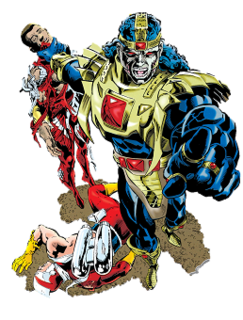Related Research Articles

Lucifer Samael Morningstar is a character who appears in American comic books published by DC Comics. He is an adaptation of Lucifer—the Biblical fallen angel and devil of Christianity—and is one of the most powerful beings in the DC Universe. Though various versions of the Devil have been presented by DC Comics, this interpretation by Neil Gaiman debuted in The Sandman #4 in 1989. Lucifer appears primarily as a supporting character in The Sandman and as the protagonist of the spin-off Lucifer.

The DC Universe (DCU) is the fictional shared universe where most stories in American comic book titles published by DC Comics take place. DC superheroes such as Superman, Batman, Wonder Woman, Martian Manhunter, The Flash, Green Lantern and Aquaman are from this universe, as well as teams such as the Justice League and the Teen Titans. It also contains well-known supervillains such as Lex Luthor, the Joker, Sinestro, Harley Quinn, Reverse-Flash, Darkseid, General Zod, Penguin, the Riddler, Catwoman, Ra’s al Ghul, Bane and Two-Face. In context, the term "DC Universe" usually refers to the main DC continuity.

The Crime Syndicate are teams of supervillains from one of DC Comics' parallel universes where they are the evil counterparts of the Justice League. The original team was specifically known as the Crime Syndicate of America and is sometimes abbreviated as CSA. This first superpowered Crime Syndicate team appeared in Justice League of America #29 in August 1964. The primary successive incarnation, known as the Crime Syndicate of Amerika, first appeared in the 2000 JLA: Earth 2 graphic novel.

Zauriel is a fictional superhero in the DC Universe. Originally a guardian angel who served Heaven for millions of years, he willingly falls to Earth to serve humanity as their champion and joins the Justice League.

The Anti-Monitor is a supervillain appearing in American comic books published by DC Comics. He served as the main antagonist of the 1985 DC Comics miniseries Crisis on Infinite Earths and later appears as an enemy to the Green Lantern Corps and the Justice League.

The Presence is a fictional character in comic books published by DC Comics. The character debuted in More Fun Comics #52, and was created by Jerry Siegel and Bernard Baily.

Linda Danvers, also known as Supergirl, is a fictional comic book superhero appearing in books published by DC Comics. Created by writer Peter David and artist Gary Frank, she debuted in Supergirl #1. She is not to be confused with Linda Lee Danvers, the secret identity used by the Kara Zor-El incarnation of Supergirl prior to the events of 1985's Crisis on Infinite Earths.

JLA: Earth 2 is a graphic novel written by Grant Morrison with art by Frank Quitely, published in 2000 by American company DC Comics.

Grayven is a supervillain published by DC Comics. He first appeared in Green Lantern v3 #74, and was created by Ron Marz and Darryl Banks making him one of the few characters related to Darkseid not to have being created by Jack Kirby.
Various divine characters have appeared in DC Comics publications over the years. This includes figures from actual mythologies and religions, as well as completely original ones.
One of the key aspects of the Modern Age of Comic Books was that it was the beginning of big events. In 1984, Marvel Comics debuted the first large crossover, Secret Wars, a storyline featuring the company's most prolific superheroes, which overlapped into a 12-issue limited series and many monthly comic books. A year later, DC Comics introduced its first large scale crossover, Crisis on Infinite Earths, which had long-term effects on the "DC Universe" continuity.

The Multiverse, within DC Comics publications, is a "cosmic construct" collecting many of the fictional universes in which the published stories take place. The worlds in this multiverse share a space and fate in common, and its structure has changed several times in the history of DC Comics. The Multiverse was originally created by Perpetua, who is the mother of the Monitor, Anti-Monitor and World Forger.

Hell is a fictional location, an infernal Underworld utilized in various American comic book stories published by DC Comics. It is the locational antithesis of the Silver City in Heaven. The DC Comics location known as Hell is based heavily on its depiction in Abrahamic mythology. Although several versions of Hell had briefly appeared before in various other DC Comics publications in the past, the official DC Comics concept of Hell was first properly established when it was mentioned in The Saga of the Swamp Thing #25–27 and was first seen in Swamp Thing Annual #2 (1985), all of which were written by Alan Moore and illustrated by Stephen Bissette and John Totleben.

DC Universe: Legacies is a 2010–2011 ten-issue comic book limited series written by Len Wein and published by DC Comics. It details the perspective of an admirer of superheroes in the DC Universe from the Golden, Silver, Bronze, and Modern eras of comic books.